Deck 5: Gases, Liquids, and Solids
Question
Question
Question
Question
Question
Question
Question
Question
Question
Question
Question
Question
Question
Question
Question
Question
Question
Question
Question
Question
Question
Question
Question
Question
Question
Question
Question
Question
Question
Question
Question
Question
Question
Question
Question
Question
Question
Question
Question
Question
Question
Question
Question
Question
Question
Question
Question
Question
Question
Question
Question
Question
Question
Question
Question
Question
Question
Question
Question
Question
Question
Question
Question
Question
Question
Question
Question
Question
Question
Question
Question
Question
Question
Question
Question
Question
Question
Question
Question
Question

Unlock Deck
Sign up to unlock the cards in this deck!
Unlock Deck
Unlock Deck
1/132
Play
Full screen (f)
Deck 5: Gases, Liquids, and Solids
1
Which law relates the pressure and temperature of a gas under conditions of constant volume?
A) Boyle's law
B) Charles's law
C) Dalton's law
D) Gay-Lussac's law
A) Boyle's law
B) Charles's law
C) Dalton's law
D) Gay-Lussac's law
D
2
If the change from A to B as represented by the models given below occurred, 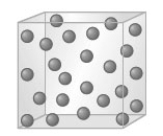
 A B which of the following is correct?
A B which of the following is correct?
A) The velocity of the particles increases.
B) The strength of the intermolecular forces increases.
C) The kinetic energy of the particles decreases.
D) both b and c

 A B which of the following is correct?
A B which of the following is correct?A) The velocity of the particles increases.
B) The strength of the intermolecular forces increases.
C) The kinetic energy of the particles decreases.
D) both b and c
C
3
Consider a substance as represented by the following models. The temperature of the substance is decreased to a very low value. 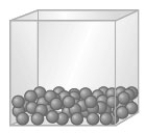

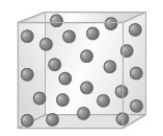 A B C
A B C
Which of the following models would best represent this substance at the lowered temperature?
A) A
B) B
C) C


 A B C
A B C
Which of the following models would best represent this substance at the lowered temperature?
A) A
B) B
C) C
B
4
Consider a substance as represented by the following models. 

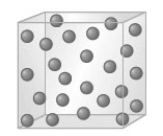 A B C When sugar is heated it forms a mass called caramel. Based on this information sugar does not normally exist as shown in which model?
A B C When sugar is heated it forms a mass called caramel. Based on this information sugar does not normally exist as shown in which model?
A) A
B) B
C) C
D) either A or C


 A B C When sugar is heated it forms a mass called caramel. Based on this information sugar does not normally exist as shown in which model?
A B C When sugar is heated it forms a mass called caramel. Based on this information sugar does not normally exist as shown in which model?A) A
B) B
C) C
D) either A or C

Unlock Deck
Unlock for access to all 132 flashcards in this deck.
Unlock Deck
k this deck
5
Which of the following instruments is used to measure atmospheric pressure?
A) an altimeter
B) a barometer
C) a manometer
D) an odometer
A) an altimeter
B) a barometer
C) a manometer
D) an odometer

Unlock Deck
Unlock for access to all 132 flashcards in this deck.
Unlock Deck
k this deck
6
Which of the following is true of the types attractive forces present in the three states of matter?
A) They are different in each of the three states.
B) They are the same in each of the three states.
C) They are the same in gases and liquids, but different in solids.
D) They are the same in liquids and solids, but different in gases.
A) They are different in each of the three states.
B) They are the same in each of the three states.
C) They are the same in gases and liquids, but different in solids.
D) They are the same in liquids and solids, but different in gases.

Unlock Deck
Unlock for access to all 132 flashcards in this deck.
Unlock Deck
k this deck
7
Which of the following exerts the greatest pressure?
A) a 20 gram object on a surface of 0.50 cm2
B) a 40 gram object on a surface of 2.0 cm2
C) a 60 gram object on a surface of 3.0 cm2
D) None, they all exert the same pressure.
A) a 20 gram object on a surface of 0.50 cm2
B) a 40 gram object on a surface of 2.0 cm2
C) a 60 gram object on a surface of 3.0 cm2
D) None, they all exert the same pressure.

Unlock Deck
Unlock for access to all 132 flashcards in this deck.
Unlock Deck
k this deck
8
Which of the following increases as temperature increases?
A) kinetic energy
B) nuclear forces
C) potential energy
D) none of these
A) kinetic energy
B) nuclear forces
C) potential energy
D) none of these

Unlock Deck
Unlock for access to all 132 flashcards in this deck.
Unlock Deck
k this deck
9
Which law relates the volume and temperature of a gas under conditions of constant pressure?
A) Avogadro's law
B) Boyle's law
C) Charles's law
D) Dalton's law
A) Avogadro's law
B) Boyle's law
C) Charles's law
D) Dalton's law

Unlock Deck
Unlock for access to all 132 flashcards in this deck.
Unlock Deck
k this deck
10
Which of the following is a unit of pressure?
A) mm of Hg
B) pascals
C) torr
D) They are all units of pressure.
A) mm of Hg
B) pascals
C) torr
D) They are all units of pressure.

Unlock Deck
Unlock for access to all 132 flashcards in this deck.
Unlock Deck
k this deck
11
Which of the following is most important in determining if a material will be a solid, a liquid or a gas?
A) covalent bonds
B) intermolecular forces
C) intramolecular forces
D) nuclear forces
A) covalent bonds
B) intermolecular forces
C) intramolecular forces
D) nuclear forces

Unlock Deck
Unlock for access to all 132 flashcards in this deck.
Unlock Deck
k this deck
12
Which of the following exerts the greatest pressure?
A) a 40 gram object on a surface of 2.0 cm2
B) a 60 gram object on a surface of 3.0 cm2
C) a 80 gram object on a surface of 4.0 cm2
D) None, they all exert the same pressure.
A) a 40 gram object on a surface of 2.0 cm2
B) a 60 gram object on a surface of 3.0 cm2
C) a 80 gram object on a surface of 4.0 cm2
D) None, they all exert the same pressure.

Unlock Deck
Unlock for access to all 132 flashcards in this deck.
Unlock Deck
k this deck
13
Which of the following is a mathematical statement of Boyle's Law?
A) P1V2 = P2V1
B) P1V1 = P2V2
C) P1/T2 = P2/T1
D) P1/T1 = P2/T2
A) P1V2 = P2V1
B) P1V1 = P2V2
C) P1/T2 = P2/T1
D) P1/T1 = P2/T2

Unlock Deck
Unlock for access to all 132 flashcards in this deck.
Unlock Deck
k this deck
14
In which state of matter are the attractive forces between molecules the weakest?
A) solid
B) liquid
C) gaseous
D) None, the attractive forces are the same in all of them.
A) solid
B) liquid
C) gaseous
D) None, the attractive forces are the same in all of them.

Unlock Deck
Unlock for access to all 132 flashcards in this deck.
Unlock Deck
k this deck
15
Which gas law is most directly related to the process of inhaling and exhaling?
A) Avogadro's law
B) Boyle's law
C) Charles's law
D) Dalton's law
A) Avogadro's law
B) Boyle's law
C) Charles's law
D) Dalton's law

Unlock Deck
Unlock for access to all 132 flashcards in this deck.
Unlock Deck
k this deck
16
Which of the following instruments is used to measure the pressure of a gas sample?
A) an altimeter
B) a barometer
C) a manometer
D) an odometer
A) an altimeter
B) a barometer
C) a manometer
D) an odometer

Unlock Deck
Unlock for access to all 132 flashcards in this deck.
Unlock Deck
k this deck
17
Which law relates the volume and pressure of a gas under conditions of constant temperature?
A) Avogadro's law
B) Boyle's law
C) Charles's law
D) Dalton's law
A) Avogadro's law
B) Boyle's law
C) Charles's law
D) Dalton's law

Unlock Deck
Unlock for access to all 132 flashcards in this deck.
Unlock Deck
k this deck
18
Air pressure can be expressed in which of the following units?
A) atmospheres
B) millimeters of Hg
C) torr
D) any of these
A) atmospheres
B) millimeters of Hg
C) torr
D) any of these

Unlock Deck
Unlock for access to all 132 flashcards in this deck.
Unlock Deck
k this deck
19
Consider the following diagram. The liquid in the apparatus is mercury. 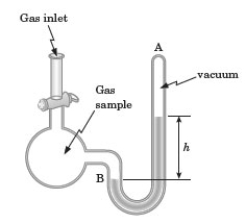 If the pressure of the gas sample on arm B is 1.0 atm, what will be the difference in the heights of the mercury column in arms A and B? This difference is represented in the diagram by the variable h?
If the pressure of the gas sample on arm B is 1.0 atm, what will be the difference in the heights of the mercury column in arms A and B? This difference is represented in the diagram by the variable h?
A) 1.0 mm Hg
B) 760 mm Hg
C) 760 atm
D) It will be equal to the current atmospheric pressure.
 If the pressure of the gas sample on arm B is 1.0 atm, what will be the difference in the heights of the mercury column in arms A and B? This difference is represented in the diagram by the variable h?
If the pressure of the gas sample on arm B is 1.0 atm, what will be the difference in the heights of the mercury column in arms A and B? This difference is represented in the diagram by the variable h?A) 1.0 mm Hg
B) 760 mm Hg
C) 760 atm
D) It will be equal to the current atmospheric pressure.

Unlock Deck
Unlock for access to all 132 flashcards in this deck.
Unlock Deck
k this deck
20
Which physical state of matter could be represented by the following model? 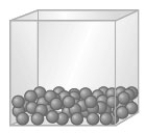
A) solid
B) liquid
C) gas

A) solid
B) liquid
C) gas

Unlock Deck
Unlock for access to all 132 flashcards in this deck.
Unlock Deck
k this deck
21
Which of the following is a mathematical statement of the combined gas law?
A) P1V2T1 = P2V1T2
B) P1V2T2 = P2V1T1
C) P1V1T2 = P2V2T1
D) P1V1T1 = P2V2T2
A) P1V2T1 = P2V1T2
B) P1V2T2 = P2V1T1
C) P1V1T2 = P2V2T1
D) P1V1T1 = P2V2T2

Unlock Deck
Unlock for access to all 132 flashcards in this deck.
Unlock Deck
k this deck
22
At constant pressure the temperature of a 4.00 L sample of gas is decreased from 400. K to 300. K. What is the new volume of the gas sample?
A) 0.188 L
B) 0.333 L
C) 3.00 L
D) 5.33 L
A) 0.188 L
B) 0.333 L
C) 3.00 L
D) 5.33 L

Unlock Deck
Unlock for access to all 132 flashcards in this deck.
Unlock Deck
k this deck
23
Which of the following is a mathematical statement of Boyle's Law?
A) P1/V2 = P2/V1
B) P1/V1 = P2/V2
C) P1/T2 = P2/T1
D) P1/T1 = P2/T2
A) P1/V2 = P2/V1
B) P1/V1 = P2/V2
C) P1/T2 = P2/T1
D) P1/T1 = P2/T2

Unlock Deck
Unlock for access to all 132 flashcards in this deck.
Unlock Deck
k this deck
24
At constant temperature the pressure on a 10.0 L sample of gas is changed from 1140 torr to 1.00 atm. What is the new volume of the gas sample?
A) 0.00877 L
B) 6.67 L
C) 15.0 L
D) 114 L
A) 0.00877 L
B) 6.67 L
C) 15.0 L
D) 114 L

Unlock Deck
Unlock for access to all 132 flashcards in this deck.
Unlock Deck
k this deck
25
Which of the following is a mathematical statement of Gay-Lussac's Law?
A) P1/V2 = P2/V1
B) P1/V1 = P2/V2
C) P1/T2 = P2/T1
D) P1/T1 = P2/T2
A) P1/V2 = P2/V1
B) P1/V1 = P2/V2
C) P1/T2 = P2/T1
D) P1/T1 = P2/T2

Unlock Deck
Unlock for access to all 132 flashcards in this deck.
Unlock Deck
k this deck
26
Suppose a balloon is filled so that its volume is 2.00 L when the pressure is 750 torr and the temperature is 24°C. What volume will it occupy if it rises to an elevation where the pressure is 375 torr and the temperature is 12°C?
A) 0.261 L
B) 0.500 L
C) 2.00 L
D) 3.84 L
A) 0.261 L
B) 0.500 L
C) 2.00 L
D) 3.84 L

Unlock Deck
Unlock for access to all 132 flashcards in this deck.
Unlock Deck
k this deck
27
At constant temperature the pressure on a 6.0 L sample of a gas is reduced from 2.0 atm to 1.0 atm. What is the new volume of the gas sample?
A) 0.083 L
B) 0.33 L
C) 3.0 L
D) 12 L
A) 0.083 L
B) 0.33 L
C) 3.0 L
D) 12 L

Unlock Deck
Unlock for access to all 132 flashcards in this deck.
Unlock Deck
k this deck
28
At constant pressure the temperature of a 4.00 L sample of gas is increased from 300. K to 400. K. What is the new volume of the gas sample?
A) 0.188 L
B) 0.300 L
C) 3.33 L
D) 5.33 L
A) 0.188 L
B) 0.300 L
C) 3.33 L
D) 5.33 L

Unlock Deck
Unlock for access to all 132 flashcards in this deck.
Unlock Deck
k this deck
29
Which of the following will occur if the temperature of a gas is increased from 20°C to 40°C at constant pressure?
A) The volume will double.
B) The volume will be halved.
C) The volume will decrease slightly.
D) The volume will increase slightly.
A) The volume will double.
B) The volume will be halved.
C) The volume will decrease slightly.
D) The volume will increase slightly.

Unlock Deck
Unlock for access to all 132 flashcards in this deck.
Unlock Deck
k this deck
30
What temperature scale should be used if we wish to express Charles's Law as a simple direct proportionality?
A) Fahrenheit
B) Celsius
C) Kelvin
D) It makes no difference.
A) Fahrenheit
B) Celsius
C) Kelvin
D) It makes no difference.

Unlock Deck
Unlock for access to all 132 flashcards in this deck.
Unlock Deck
k this deck
31
Which of the following is a mathematical statement of Gay-Lussac's Law?
A) P1V2 = P2V1
B) P1V1 = P2V2
C) P1T2 = P2T1
D) P1T1 = P2T2
A) P1V2 = P2V1
B) P1V1 = P2V2
C) P1T2 = P2T1
D) P1T1 = P2T2

Unlock Deck
Unlock for access to all 132 flashcards in this deck.
Unlock Deck
k this deck
32
Which of the following is a mathematical statement of Charles's Law?
A) P1/V2 = P2/V1
B) P1/V1 = P2/V2
C) V1/T2 = V2/T1
D) V1/T1 = V2/T2
A) P1/V2 = P2/V1
B) P1/V1 = P2/V2
C) V1/T2 = V2/T1
D) V1/T1 = V2/T2

Unlock Deck
Unlock for access to all 132 flashcards in this deck.
Unlock Deck
k this deck
33
Suppose a balloon is filled so that its volume is 2.00 L when the pressure is 1.10 atm and the temperature is 300 K. What volume will it occupy if it rises to an elevation where the pressure is 418 mm Hg and the temperature is 200 K?
A) 3.30 L
B) 2.67 L
C) 0.375 L
D) 0.303 L
A) 3.30 L
B) 2.67 L
C) 0.375 L
D) 0.303 L

Unlock Deck
Unlock for access to all 132 flashcards in this deck.
Unlock Deck
k this deck
34
The combined gas law combines which gas laws?
A) Boyle's and Charles's
B) Charles's and Gay-Lussac's
C) Boyle's and Gay-Lussac's
D) Boyle's, Charles's and Gay-Lussac's
A) Boyle's and Charles's
B) Charles's and Gay-Lussac's
C) Boyle's and Gay-Lussac's
D) Boyle's, Charles's and Gay-Lussac's

Unlock Deck
Unlock for access to all 132 flashcards in this deck.
Unlock Deck
k this deck
35
Which of the following is a mathematical statement of the combined gas law?
A) P1V2/T1 = P2V1/T2
B) P1V2/T2 = P2V1/T1
C) P1V1/T2 = P2V2/T1
D) P1V1/T1 = P2V2/T2
A) P1V2/T1 = P2V1/T2
B) P1V2/T2 = P2V1/T1
C) P1V1/T2 = P2V2/T1
D) P1V1/T1 = P2V2/T2

Unlock Deck
Unlock for access to all 132 flashcards in this deck.
Unlock Deck
k this deck
36
At constant pressure the temperature of a 4.0 L sample of gas is decreased from 50. °C to 25 °C. What is the new volume of the gas sample?
A) 2.00 L
B) 3.69 L
C) 4.34 L
D) 8.00 L
A) 2.00 L
B) 3.69 L
C) 4.34 L
D) 8.00 L

Unlock Deck
Unlock for access to all 132 flashcards in this deck.
Unlock Deck
k this deck
37
Which of the following is a mathematical statement of Charles's Law?
A) P1V2 = P2V1
B) P1V1 = P2V2
C) V1T2 = V2T1
D) V1T1 = V2T2
A) P1V2 = P2V1
B) P1V1 = P2V2
C) V1T2 = V2T1
D) V1T1 = V2T2

Unlock Deck
Unlock for access to all 132 flashcards in this deck.
Unlock Deck
k this deck
38
At constant pressure the temperature of a 4.00 L sample of gas is increased from 25 °C to 50.°C. What is the new volume of the gas sample?
A) 2.00 L
B) 3.69 L
C) 4.34 L
D) 8.00 L
A) 2.00 L
B) 3.69 L
C) 4.34 L
D) 8.00 L

Unlock Deck
Unlock for access to all 132 flashcards in this deck.
Unlock Deck
k this deck
39
At constant temperature the pressure on a 6.0 L sample of gas is increased from 1.0 atm to 2.0 atm. What is the new volume of the gas sample?
A) 0.33 L
B) 0.67 K
C) 1.5 L
D) 3.0 L
A) 0.33 L
B) 0.67 K
C) 1.5 L
D) 3.0 L

Unlock Deck
Unlock for access to all 132 flashcards in this deck.
Unlock Deck
k this deck
40
At constant temperature the pressure on a 10.0 L sample of gas is changed from 1.00 atm to 1140 torr. What is the new volume of the gas sample?
A) 0.00877 L
B) 6.67 L
C) 15.0 L
D) 114 L
A) 0.00877 L
B) 6.67 L
C) 15.0 L
D) 114 L

Unlock Deck
Unlock for access to all 132 flashcards in this deck.
Unlock Deck
k this deck
41
What is the volume occupied by an 8.00 gram sample of molecular oxygen at STP?
A) 5.60 L
B) 11.2 L
C) 22.4 L
D) 44.8 L
A) 5.60 L
B) 11.2 L
C) 22.4 L
D) 44.8 L

Unlock Deck
Unlock for access to all 132 flashcards in this deck.
Unlock Deck
k this deck
42
A certain quantity of neon gas is under 1.05 atm pressure at 303 K in a 10.0 L vessel. How many moles of neon are present?
A) 0.222 mol
B) 0.402 mol
C) 0.422 mol
D) 2.37 mol
A) 0.222 mol
B) 0.402 mol
C) 0.422 mol
D) 2.37 mol

Unlock Deck
Unlock for access to all 132 flashcards in this deck.
Unlock Deck
k this deck
43
Which of the following is a mathematical statement of the ideal gas law?
A) PV = n/RT
B) PV = nRT
C) V = nP/RT
D) PV = RT/n
A) PV = n/RT
B) PV = nRT
C) V = nP/RT
D) PV = RT/n

Unlock Deck
Unlock for access to all 132 flashcards in this deck.
Unlock Deck
k this deck
44
Standard temperature and pressure are which of the following?
A) 0 °C and 1 atm
B) 32 °F and 1 atm
C) 273 K and 1 atm
D) all of these
A) 0 °C and 1 atm
B) 32 °F and 1 atm
C) 273 K and 1 atm
D) all of these

Unlock Deck
Unlock for access to all 132 flashcards in this deck.
Unlock Deck
k this deck
45
A sample of carbon dioxide occupies 22.4 L at STP. Which of the following statements apply to the sample?
A) The sample contains 6.02 × 1023 carbon atoms.
B) The sample contains 6.02 × 1023 molecules.
C) Both a and b are correct.
D) Neither a nor b is correct.
A) The sample contains 6.02 × 1023 carbon atoms.
B) The sample contains 6.02 × 1023 molecules.
C) Both a and b are correct.
D) Neither a nor b is correct.

Unlock Deck
Unlock for access to all 132 flashcards in this deck.
Unlock Deck
k this deck
46
Which of the following could be a correct set of units for the ideal gas law constant, R?
A) L/mol
B) L·atm/mol
C) L·atm/mol·K
D) L·atm·mol·K
A) L/mol
B) L·atm/mol
C) L·atm/mol·K
D) L·atm·mol·K

Unlock Deck
Unlock for access to all 132 flashcards in this deck.
Unlock Deck
k this deck
47
Which of the following is called standard temperature and pressure?
A) 0°C and 1 atm
B) 0°F and 1 atm
C) 0 K and 1 atm
D) none of these
A) 0°C and 1 atm
B) 0°F and 1 atm
C) 0 K and 1 atm
D) none of these

Unlock Deck
Unlock for access to all 132 flashcards in this deck.
Unlock Deck
k this deck
48
If a 7.00 gram sample of molecular nitrogen at 10. °C occupies 2.50 L, what is the pressure of the sample?
A) 1.28 atm
B) 2.32 atm
C) 2.56 atm
D) 4.65 atm
A) 1.28 atm
B) 2.32 atm
C) 2.56 atm
D) 4.65 atm

Unlock Deck
Unlock for access to all 132 flashcards in this deck.
Unlock Deck
k this deck
49
If an 8.00 gram sample of molecular oxygen at 1.00 atm pressure occupies 3.00 L, what is the temperature of the sample?
A) 146°C
B) 146 K
C) 73°C
D) 73 K
A) 146°C
B) 146 K
C) 73°C
D) 73 K

Unlock Deck
Unlock for access to all 132 flashcards in this deck.
Unlock Deck
k this deck
50
Which law relates the volume and number of molecules of a gas under conditions of constant temperature and pressure?
A) Avogadro's law
B) Boyle's law
C) Charles's law
D) Dalton's law
A) Avogadro's law
B) Boyle's law
C) Charles's law
D) Dalton's law

Unlock Deck
Unlock for access to all 132 flashcards in this deck.
Unlock Deck
k this deck
51
A student has equal-volume samples of three gases. All the gases are at the same temperature and pressure. If the three gases are O2, CO2, NH3, which sample contains the largest number of atoms?
A) O2
B) CO2
C) NH3
D) None, they all contain the same number of atoms.
A) O2
B) CO2
C) NH3
D) None, they all contain the same number of atoms.

Unlock Deck
Unlock for access to all 132 flashcards in this deck.
Unlock Deck
k this deck
52
A student obtained experimental data and plotted it graphically, but forgot to label the axes of the graph. How should the axes of the graph shown here be labeled? 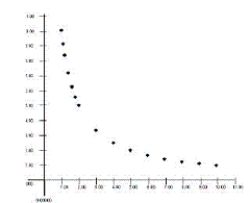
A) the x-axis is the T and the y-axis is V
B) the x-axis is the T and the y-axis is P
C) the x-axis is the P and the y-axis is V
D) the x-axis is the P and the y-axis is T

A) the x-axis is the T and the y-axis is V
B) the x-axis is the T and the y-axis is P
C) the x-axis is the P and the y-axis is V
D) the x-axis is the P and the y-axis is T

Unlock Deck
Unlock for access to all 132 flashcards in this deck.
Unlock Deck
k this deck
53
If 2.00 moles of NO gas occupies 10.0 L at 295 K, what is the pressure of the gas in atmospheres?
A) 0.206 atm
B) 2.42 atm
C) 4.84 atm
D) 9.33 atm
A) 0.206 atm
B) 2.42 atm
C) 4.84 atm
D) 9.33 atm

Unlock Deck
Unlock for access to all 132 flashcards in this deck.
Unlock Deck
k this deck
54
Which of the following will occur if the temperature of a gas is decreased from 60 K to 30 K at constant pressure?
A) The volume will double.
B) The volume will be halved.
C) The volume will decrease slightly.
D) The volume will increase slightly.
A) The volume will double.
B) The volume will be halved.
C) The volume will decrease slightly.
D) The volume will increase slightly.

Unlock Deck
Unlock for access to all 132 flashcards in this deck.
Unlock Deck
k this deck
55
A student has equal-volume samples of three gases. All the gases are at the same temperature and pressure. If the three gases are O2, CO2, NH3, which sample contains the largest number of molecules?
A) O2
B) CO2
C) NH3
D) None, they all contain the same number of molecules.
A) O2
B) CO2
C) NH3
D) None, they all contain the same number of molecules.

Unlock Deck
Unlock for access to all 132 flashcards in this deck.
Unlock Deck
k this deck
56
A sample of carbon dioxide occupies 22.4 L at STP. Which of the following statements apply to the sample?
A) The sample contains 6.02 × 1023 atoms.
B) The sample contains 6.02 × 1023 atoms of oxygen.
C) The sample contains 6.02 × 1023 molecules.
D) None of the above is correct.
A) The sample contains 6.02 × 1023 atoms.
B) The sample contains 6.02 × 1023 atoms of oxygen.
C) The sample contains 6.02 × 1023 molecules.
D) None of the above is correct.

Unlock Deck
Unlock for access to all 132 flashcards in this deck.
Unlock Deck
k this deck
57
Which of the following will occur if the temperature of a gas is increased from 20 K to 40 K at constant pressure?
A) The volume will double.
B) The volume will be halved.
C) The volume will decrease slightly.
D) The volume will increase slightly.
A) The volume will double.
B) The volume will be halved.
C) The volume will decrease slightly.
D) The volume will increase slightly.

Unlock Deck
Unlock for access to all 132 flashcards in this deck.
Unlock Deck
k this deck
58
A gas is expanded from an initial volume of 20.5 L at 0.92 atm at 23 °C to a final volume of 34.6 L. During the expansion the gas cools to 12 °C. What is the final pressure?
A) 0.28 atm
B) 0.52 atm
C) 0.57 atm
D) 1.9 atm
A) 0.28 atm
B) 0.52 atm
C) 0.57 atm
D) 1.9 atm

Unlock Deck
Unlock for access to all 132 flashcards in this deck.
Unlock Deck
k this deck
59
Which of the following is a mathematical statement of the ideal gas law?
A) PVRT = n
B) PV/RT = n
C) VRT/P = n
D) n = RT/PV
A) PVRT = n
B) PV/RT = n
C) VRT/P = n
D) n = RT/PV

Unlock Deck
Unlock for access to all 132 flashcards in this deck.
Unlock Deck
k this deck
60
Which of the following will occur if the temperature of a gas is decreased from 60°C to 30°C at constant pressure?
A) The volume will double.
B) The volume will be halved.
C) The volume will decrease slightly.
D) The volume will increase slightly.
A) The volume will double.
B) The volume will be halved.
C) The volume will decrease slightly.
D) The volume will increase slightly.

Unlock Deck
Unlock for access to all 132 flashcards in this deck.
Unlock Deck
k this deck
61
A closed flask contains a 0.25 moles of O2 which exerts a pressure of 0.50 atm. If 0.75 moles of CO2 is added to the container what is the total pressure in the flask?
A) 0.50 atm
B) 1.0 atm
C) 1.5 atm
D) 2.0 atm
A) 0.50 atm
B) 1.0 atm
C) 1.5 atm
D) 2.0 atm

Unlock Deck
Unlock for access to all 132 flashcards in this deck.
Unlock Deck
k this deck
62
According to the kinetic molecular theory, which of the following is not true?
A) The average kinetic energy of gas particles is proportional to the Celsius temperature.
B) Gas molecules are assumed to have no volume.
C) Gas pressure is caused by collisions between gas molecules and the container walls.
D) None, all of the above are true.
A) The average kinetic energy of gas particles is proportional to the Celsius temperature.
B) Gas molecules are assumed to have no volume.
C) Gas pressure is caused by collisions between gas molecules and the container walls.
D) None, all of the above are true.

Unlock Deck
Unlock for access to all 132 flashcards in this deck.
Unlock Deck
k this deck
63
For small molecules, which of the following usually is the weakest intermolecular interaction?
A) covalent bonding
B) dipole-dipole interactions
C) London dispersion forces
D) hydrogen bonding
A) covalent bonding
B) dipole-dipole interactions
C) London dispersion forces
D) hydrogen bonding

Unlock Deck
Unlock for access to all 132 flashcards in this deck.
Unlock Deck
k this deck
64
According to the kinetic molecular theory, which of the following is not true?
A) Gas molecules are assumed to have no volume.
B) Gas pressure is caused by collisions between gas molecules and the container walls.
C) When gas molecules collide they stick together.
D) None, all of the above are true.
A) Gas molecules are assumed to have no volume.
B) Gas pressure is caused by collisions between gas molecules and the container walls.
C) When gas molecules collide they stick together.
D) None, all of the above are true.

Unlock Deck
Unlock for access to all 132 flashcards in this deck.
Unlock Deck
k this deck
65
Which of the following is not an example of an intermolecular attraction?
A) covalent bonding
B) dipole-dipole interactions
C) London dispersion forces
D) hydrogen bonding
A) covalent bonding
B) dipole-dipole interactions
C) London dispersion forces
D) hydrogen bonding

Unlock Deck
Unlock for access to all 132 flashcards in this deck.
Unlock Deck
k this deck
66
An unknown amount of He gas occupies 30.5 L at 2.00 atm pressure and 300. K. What is the weight of the gas in the container?
A) 2.48 g
B) 4.95 g
C) 9.91 g
D) 19.8 g
A) 2.48 g
B) 4.95 g
C) 9.91 g
D) 19.8 g

Unlock Deck
Unlock for access to all 132 flashcards in this deck.
Unlock Deck
k this deck
67
According to the kinetic molecular theory, which of the following is not true?
A) The average kinetic energy of gas particles is proportional to the Kelvin temperature.
B) Gas molecules are assumed to have no volume.
C) Gas pressure is caused by collisions between gas molecules and the container walls.
D) None, all of the above are true.
A) The average kinetic energy of gas particles is proportional to the Kelvin temperature.
B) Gas molecules are assumed to have no volume.
C) Gas pressure is caused by collisions between gas molecules and the container walls.
D) None, all of the above are true.

Unlock Deck
Unlock for access to all 132 flashcards in this deck.
Unlock Deck
k this deck
68
According to the kinetic molecular theory, which of the following is not true?
A) Gas molecules are assumed to have no volume.
B) Gas pressure is caused by collisions between gas molecules and the container walls.
C) When gas molecules collide energy is lost.
D) None, all of the above are true.
A) Gas molecules are assumed to have no volume.
B) Gas pressure is caused by collisions between gas molecules and the container walls.
C) When gas molecules collide energy is lost.
D) None, all of the above are true.

Unlock Deck
Unlock for access to all 132 flashcards in this deck.
Unlock Deck
k this deck
69
Which of the following is necessary for a molecule engage in hydrogen bonding?
A) A hydrogen atom is covalently bonded to a nitrogen atom.
B) A hydrogen atom is covalently bonded to an oxygen atom.
C) Both a and b are correct.
D) Neither a nor b is correct.
A) A hydrogen atom is covalently bonded to a nitrogen atom.
B) A hydrogen atom is covalently bonded to an oxygen atom.
C) Both a and b are correct.
D) Neither a nor b is correct.

Unlock Deck
Unlock for access to all 132 flashcards in this deck.
Unlock Deck
k this deck
70
Which law applies only to mixtures of gases?
A) Avogadro's law
B) Boyle's law
C) Charles's law
D) Dalton's law
A) Avogadro's law
B) Boyle's law
C) Charles's law
D) Dalton's law

Unlock Deck
Unlock for access to all 132 flashcards in this deck.
Unlock Deck
k this deck
71
Dry air is 78.08% nitrogen, 20.95% oxygen and 0.93% argon with the 0.04% being other gases. If the atmospheric pressure is 760.0 torr, what is the partial pressure of oxygen in dry air?
A) 20.95 torr
B) 159.2 torr
C) 600.8 torr
D) 760.0 torr
A) 20.95 torr
B) 159.2 torr
C) 600.8 torr
D) 760.0 torr

Unlock Deck
Unlock for access to all 132 flashcards in this deck.
Unlock Deck
k this deck
72
Which of the following is true of London dispersion forces?
A) They decrease as the number of electrons in a molecule increases.
B) They are only present in some molecules.
C) Both a and b are correct.
D) Neither a nor b is correct.
A) They decrease as the number of electrons in a molecule increases.
B) They are only present in some molecules.
C) Both a and b are correct.
D) Neither a nor b is correct.

Unlock Deck
Unlock for access to all 132 flashcards in this deck.
Unlock Deck
k this deck
73
Dry air is 78.08% nitrogen, 20.95% oxygen and 0.93% argon with the 0.04% being other gases. If the atmospheric pressure is 760.0 torr, what is the partial pressure of nitrogen in dry air?
A) 78.08 torr
B) 166.6 torr
C) 593.4 torr
D) 760.0 torr
A) 78.08 torr
B) 166.6 torr
C) 593.4 torr
D) 760.0 torr

Unlock Deck
Unlock for access to all 132 flashcards in this deck.
Unlock Deck
k this deck
74
Which of the following is true of London dispersion forces?
A) They increase as the number of electrons in a molecule increases.
B) They are only present in some molecules.
C) Both a and b are correct.
D) Neither a nor b is correct.
A) They increase as the number of electrons in a molecule increases.
B) They are only present in some molecules.
C) Both a and b are correct.
D) Neither a nor b is correct.

Unlock Deck
Unlock for access to all 132 flashcards in this deck.
Unlock Deck
k this deck
75
Which of the following is the strongest intermolecular interaction?
A) covalent bonding
B) dipole-dipole interactions
C) London dispersion forces
D) hydrogen bonding
A) covalent bonding
B) dipole-dipole interactions
C) London dispersion forces
D) hydrogen bonding

Unlock Deck
Unlock for access to all 132 flashcards in this deck.
Unlock Deck
k this deck
76
Which of the following might correspond to the O2 pressure in a hyperbaric chamber?
A) 160 torr
B) 760 torr
C) 1600 torr
D) none of these
A) 160 torr
B) 760 torr
C) 1600 torr
D) none of these

Unlock Deck
Unlock for access to all 132 flashcards in this deck.
Unlock Deck
k this deck
77
A vessel under 2.015 atm pressure contains nitrogen, N2, and water vapor, H2O. The partial pressure of N2 is 1.908 atm. What is the partial pressure of the water vapor?
A) 0.107 atm
B) 1.908 atm
C) 2.015 atm
D) 3.923 atm
A) 0.107 atm
B) 1.908 atm
C) 2.015 atm
D) 3.923 atm

Unlock Deck
Unlock for access to all 132 flashcards in this deck.
Unlock Deck
k this deck
78
Which type of intermolecular attraction exists for all molecules?
A) covalent bonding
B) dipole-dipole interactions
C) London dispersion forces
D) hydrogen bonding
A) covalent bonding
B) dipole-dipole interactions
C) London dispersion forces
D) hydrogen bonding

Unlock Deck
Unlock for access to all 132 flashcards in this deck.
Unlock Deck
k this deck
79
Which of the following have an effect on the strength of London dispersion forces?
A) the number of electrons
B) size
C) shape
D) all of them
A) the number of electrons
B) size
C) shape
D) all of them

Unlock Deck
Unlock for access to all 132 flashcards in this deck.
Unlock Deck
k this deck
80
A closed flask contains a 0.25 moles of O2 which exerts a pressure of 0.50 atm. If 0.75 moles of CO2 is added to the container what is the pressure of oxygen?
A) 0.50 atm
B) 1.0 atm
C) 1.5 atm
D) 2.0 atm
A) 0.50 atm
B) 1.0 atm
C) 1.5 atm
D) 2.0 atm

Unlock Deck
Unlock for access to all 132 flashcards in this deck.
Unlock Deck
k this deck



